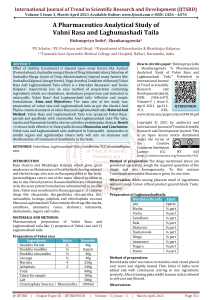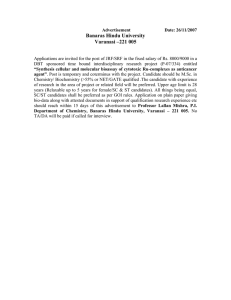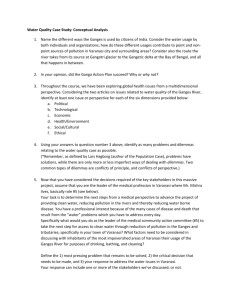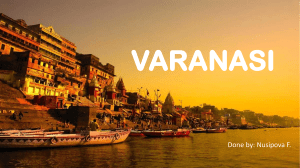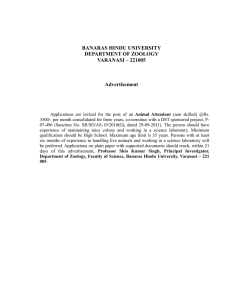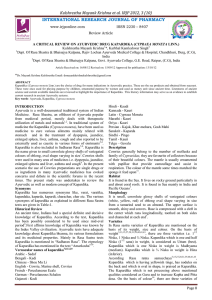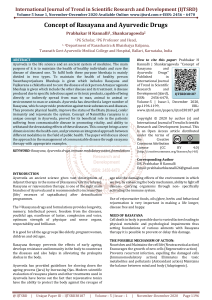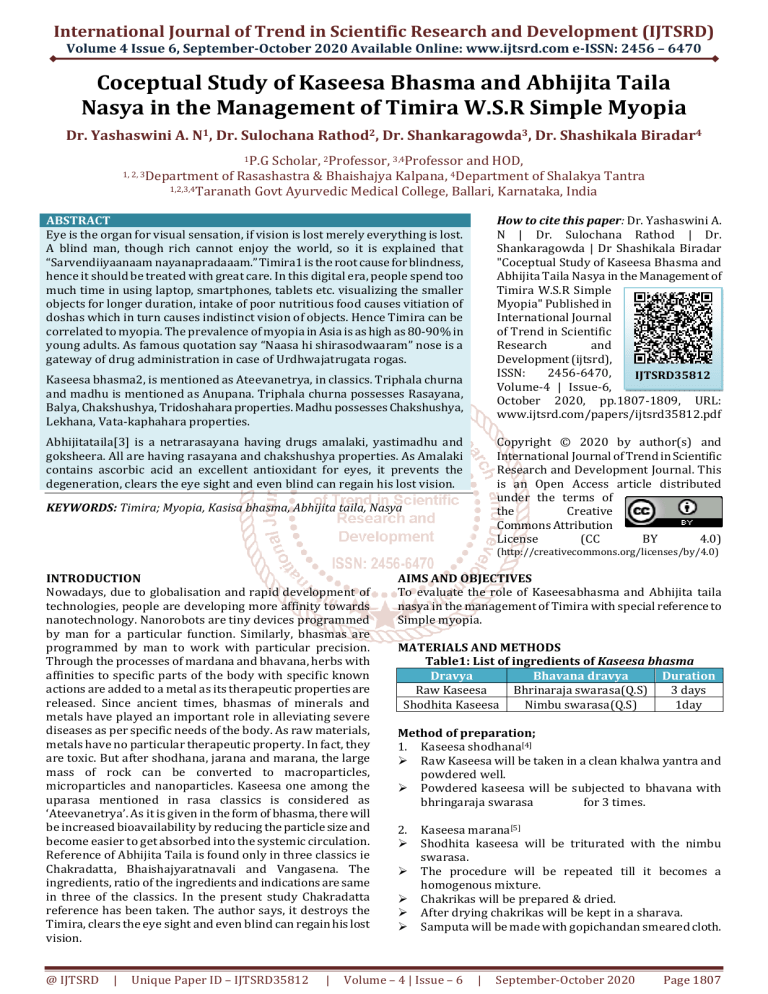
International Journal of Trend in Scientific Research and Development (IJTSRD)
Volume 4 Issue 6, September-October 2020 Available Online: www.ijtsrd.com e-ISSN: 2456 – 6470
Coceptual Study of Kaseesa Bhasma and Abhijita Taila
Nasya in the Management of Timira W.S.R Simple Myopia
Dr. Yashaswini A. N1, Dr. Sulochana Rathod2, Dr. Shankaragowda3, Dr. Shashikala Biradar4
1P.G
Scholar, 2Professor, 3,4Professor and HOD,
of Rasashastra & Bhaishajya Kalpana, 4Department of Shalakya Tantra
1,2,3,4Taranath Govt Ayurvedic Medical College, Ballari, Karnataka, India
1, 2, 3Department
How to cite this paper: Dr. Yashaswini A.
N | Dr. Sulochana Rathod | Dr.
Shankaragowda | Dr Shashikala Biradar
"Coceptual Study of Kaseesa Bhasma and
Abhijita Taila Nasya in the Management of
Timira W.S.R Simple
Myopia" Published in
International Journal
of Trend in Scientific
Research
and
Development (ijtsrd),
ISSN:
2456-6470,
IJTSRD35812
Volume-4 | Issue-6,
October 2020, pp.1807-1809, URL:
www.ijtsrd.com/papers/ijtsrd35812.pdf
ABSTRACT
Eye is the organ for visual sensation, if vision is lost merely everything is lost.
A blind man, though rich cannot enjoy the world, so it is explained that
“Sarvendiiyaanaam nayanapradaaam.” Timira1 is the root cause for blindness,
hence it should be treated with great care. In this digital era, people spend too
much time in using laptop, smartphones, tablets etc. visualizing the smaller
objects for longer duration, intake of poor nutritious food causes vitiation of
doshas which in turn causes indistinct vision of objects. Hence Timira can be
correlated to myopia. The prevalence of myopia in Asia is as high as 80-90% in
young adults. As famous quotation say “Naasa hi shirasodwaaram” nose is a
gateway of drug administration in case of Urdhwajatrugata rogas.
Kaseesa bhasma2, is mentioned as Ateevanetrya, in classics. Triphala churna
and madhu is mentioned as Anupana. Triphala churna possesses Rasayana,
Balya, Chakshushya, Tridoshahara properties. Madhu possesses Chakshushya,
Lekhana, Vata-kaphahara properties.
Abhijitataila[3] is a netrarasayana having drugs amalaki, yastimadhu and
goksheera. All are having rasayana and chakshushya properties. As Amalaki
contains ascorbic acid an excellent antioxidant for eyes, it prevents the
degeneration, clears the eye sight and even blind can regain his lost vision.
Copyright © 2020 by author(s) and
International Journal of Trend in Scientific
Research and Development Journal. This
is an Open Access article distributed
under the terms of
the
Creative
Commons Attribution
License
(CC
BY
4.0)
KEYWORDS: Timira; Myopia, Kasisa bhasma, Abhijita taila, Nasya
(http://creativecommons.org/licenses/by/4.0)
INTRODUCTION
Nowadays, due to globalisation and rapid development of
technologies, people are developing more affinity towards
nanotechnology. Nanorobots are tiny devices programmed
by man for a particular function. Similarly, bhasmas are
programmed by man to work with particular precision.
Through the processes of mardana and bhavana, herbs with
affinities to specific parts of the body with specific known
actions are added to a metal as its therapeutic properties are
released. Since ancient times, bhasmas of minerals and
metals have played an important role in alleviating severe
diseases as per specific needs of the body. As raw materials,
metals have no particular therapeutic property. In fact, they
are toxic. But after shodhana, jarana and marana, the large
mass of rock can be converted to macroparticles,
microparticles and nanoparticles. Kaseesa one among the
uparasa mentioned in rasa classics is considered as
‘Ateevanetrya’. As it is given in the form of bhasma, there will
be increased bioavailability by reducing the particle size and
become easier to get absorbed into the systemic circulation.
Reference of Abhijita Taila is found only in three classics ie
Chakradatta, Bhaishajyaratnavali and Vangasena. The
ingredients, ratio of the ingredients and indications are same
in three of the classics. In the present study Chakradatta
reference has been taken. The author says, it destroys the
Timira, clears the eye sight and even blind can regain his lost
vision.
@ IJTSRD
|
Unique Paper ID – IJTSRD35812
|
AIMS AND OBJECTIVES
To evaluate the role of Kaseesabhasma and Abhijita taila
nasya in the management of Timira with special reference to
Simple myopia.
MATERIALS AND METHODS
Table1: List of ingredients of Kaseesa bhasma
Dravya
Bhavana dravya
Duration
Raw Kaseesa
Bhrinaraja swarasa(Q.S)
3 days
Shodhita Kaseesa
Nimbu swarasa(Q.S)
1day
Method of preparation;
1. Kaseesa shodhana[4]
Raw Kaseesa will be taken in a clean khalwa yantra and
powdered well.
Powdered kaseesa will be subjected to bhavana with
bhringaraja swarasa
for 3 times.
2.
Kaseesa marana[5]
Shodhita kaseesa will be triturated with the nimbu
swarasa.
The procedure will be repeated till it becomes a
homogenous mixture.
Chakrikas will be prepared & dried.
After drying chakrikas will be kept in a sharava.
Samputa will be made with gopichandan smeared cloth.
Volume – 4 | Issue – 6
|
September-October 2020
Page 1807
International Journal of Trend in Scientific Research and Development (IJTSRD) @ www.ijtsrd.com eISSN: 2456-6470
Then it will be subjected for puta with dashaprastha
vanopala.
This procedure is continued till bhasma appears
niramlatwa and develops gairika varna(red color).
Preparation of Abhijita taila
• TilaTaila murchana[6]
Tilataila is boiled in a vessel till it becomes free from
froath.
Water and the kalka of the following drugs are added
and boiled on mild fire.
Table 2: List of ingredients of Tila taila murchana
Drug
Quantity
Tilataila
1part
Manjishta 1/16th part
Haritaki
1/64thpart
Vibhitaki
1/64thpart
Amalaki
1/64th part
Bala
1/64thpart
Haridra
1/64thpart
Musta
1/64th part
Lodhra
1/64thpart
Ketaki
1/64thpart
Nyagrodha 1/64thpart
Nalika
1/64thpart
Water
4parts
Procedure:
General method of taila preparation is adopted, Taila will be
prepared with the above drugs by adding Kalka and Drava
Dravya mixed together to the sneha taken in the specified
quantity. Boil the total contents in mriduagni and stir
continuously so that the kalka is not allowed to adhere to the
vessel. Boiling is continued till the sneha siddhi lakshanas[7]
are obtained.
Preparation of Abhijita taila:[8]
Table 3: List of ingredients of Abhijita Taila
Kalkadravya 1) Yastimadhu
1 part
Snehadravya 1) Murchita Tilataila
4 parts
1) Amalakiswarasa
16 parts
Dravadravya
2) Ksheera
16 parts
Amalakiswarasa –Swarasa is to be extracted from the
pulp of amalaki fruit.
clinical features based on involvement of Patalas & vitiation
of Doshas. So the treatment of the Timira depends upon the
stage and dominance of particular Doshas. For which Local &
systemic management has described by Acharyas. It
disturbes the physiology of visual perception and even
terminates in blindness. Many of the clinical features
described for timira are having similarities with the
refractive errors. In brief, the management essentially
consists of the avoidancce of aetiological factors; and
specifically, in detail, it implies counteracting the increased
vata and other Doshas.[9]
Propable Mode of Action of Kaseesa Bhasma:
Kaseesa is one among the rasa dravya grouped under
Uparasa varga in Rasa classics. Kaseesa is also one of the
Nirendriya drug, hence Bhringaraja swarasa is used as
shodhana dravya to increase its therapeutic efficacy and
converted to Sendriya dravya.
Kaseesa having Kashaya, Amla rasa, singdha , guru guna
ushna
veerya,
Vata-kaphahara,
Ateevanetrya,
Rasavadgunakara.
Rasavadgunakara can be taken as Balya, Rasayana
properties of Parada and Yogavahi- it takes the gunas of
Bhringaraja and Nimbu during Bhavana and Triphala as
anupana.
Bhringaraja: It has Katu, Tikta rasa, Ushna veerya and
Katu vipaka.It has Laghu, Rooksha Guna and is
Kaphavatashamaka.
It is considered as Chakshushya, Rasyana.It has
antioxidant, muscle relaxant, anti-hemorrhagic
property, analgesic property.
It also contains polypeptides, Fe, Vitamin E, Ca, Mg in
minor elements which helps in improving the vision.
Nimbu: It has Amla rasa, Ushna veerya and Amla vipaka.
It has Guru, Teekshna Guna and is Kapha vata shamaka.
It is a rich source of Vitamin C and minor elements like
Ca, K, Se Zn, Mg, etc. It helps in absorption of Iron into
the systemic circulation.
Triphala churna also contains Rasayana, Balya,
Chakshushya, Tridoshahara properties.
Madhu is having Chakshushya, Lekhana, Vata-kaphahara
properties.
Kaseesa Bhasma given in the Ferrous form, iron is better
absorbed into the system.
It acts as Shamanaushadhi, hence it should be given for
longer period to prevent the recurrence of the disease
Timira.
Procedure:
General method of taila preparation is adopted, Taila will be
prepared with the above drugs by adding Kalka and Drava
Dravya mixed together to the snehna taken in the specified
quantity. Boil the total contents in mriduagni and stir
continuously so that the kalka is not allowed to adhere to the
vessel. Boiling is continued till the sneha siddhi lakshanas[7]
are obtained.
Dose: 125mg TID
Anupana: Triphala churna and Madhu
Importance of Nasya in Timira [10] :
Acharya Sushrutha suggests the administration of Nasya in
Timira. It should be administered in in such a condition
where doshas are not in viplutagati. It can be narrated as
“Doshodaye naiva cha viplutagate dravyani nasyadishu
yojayedbudhaha” In early stage of Timira, when the
symptoms of the vitiated Doshas have just manifested but
have not involved the whole eye, these should be treated by
Nasya, collyriums and other purification measures.
DISCUSSION
Timira is one of the grave diseases posing challenge to the
eyesight, which starts from Avyakta darshana and ends in
complete loss of vision i.e. Linganasha. Its literally meaning
is darkness. No Separate etiological factors have been
mentioned for Timira in Ayurvedic classics. So general
etiological factors of the eye are to be considered Timira. Its
Propable Mode of Action of Abhijita Taila:
Amalaki: It has Lavana Varjita Pancharasa, Sheeta
Veerya and Madhura Vipaka.
It has Laghu Rooksha Guna and is Tridosha Shamaka. It
is considered as best Chakshushya, Rasayana and
Medhya.Its rejuvenating (vyasthapaka) property at
cellular level imparts vision sustainability, hence it said
@ IJTSRD
|
Unique Paper ID – IJTSRD35812
|
Volume – 4 | Issue – 6
|
September-October 2020
Page 1808
International Journal of Trend in Scientific Research and Development (IJTSRD) @ www.ijtsrd.com eISSN: 2456-6470
Chakshushya.It contains Vitamin C and Iron which are
beneficial for improving vision. It has antioxidant
property and has the free-radical scavenging action.
Yastimadhu: It has Madhura Rasa, Madhura Vipaka,
Guru Singdha Guna and Sheeta Veerya and hence, is a
Pitha Shamaka.It is also a Vata Shamaka. It is a
Chakshushya,Balya and Rasayana.It has Glycyrrhizin and
Wedelolactone
which
has
anti-inflammatory
property.It’s also a potent antioxidant.
Goksheera:It has been mentioned under Ajasrika
Rasayana. It has Madhura Rasa, Guru, Sheeta, Snigdha
Guna, Sheeta Veerya and Madhura Vipaka.
It contains the fat soluble Vitamins A, D, E, K and water
soluble Vitamins B1,B2, B3, B5, B6, B12 and C.
Vitamin E or Tocopherol is potent Antioxidant and
Neutralizes free radicals which causes tissue cellular
damage.
All the dravyas are having Madhura rasa, Madhura
vipaka,
Sheeta
veerya,
Guru-Snigdha
guna,
Pittashamaka, Rasayana, Balya and Chakshushya hence
acts asdrusti prasadana, relieves in symptoms as well as
recurrence of the disease Timira.
CONCLUSION
Kaseesa Bhasma can be advised for symptomatic relief.
Kaseesa bhasma given as shamanoushadhi does shamana of
the vyadhi where in recurrence of the vyadhi is less
compared to Abhijita Taila nasya given group. Timira is a
tridosha vikara having most chronicity and has the tendency
to re-occur, better results can be obtained on giving Nasya as
it is a shodhana therapy which helps in expulsion of doshas
from the body.
REFERENCES
[1] Acharyasushruta.
Sushrutasamhita
with
Nibandhasangraha commentary by Sri Dalhana and
Nyachandrika panjika by Sri Gayadasa on
Nidanasthana. edited by Vaidya Acharya jadavji
Trikamji and Acharya Ram Narayan.8th edition.
Varanasi: Chaukamba orientalia; 2005, Uttarasthana,
17thChapter, verse 46, 630 pp.
[2]
Sri Vagbhatacharya. Rasaratna samuchaya. With
Tatwarthabodhini hindi commentary by Pandit Sri
Dharmanandasharma.2nd edition. New delhi-Motilalba
narasidas; 1996.3rd chapter, verse 54,45pp.
@ IJTSRD
|
Unique Paper ID – IJTSRD35812
|
[3]
Chakrapanidatta. Chakradatta. with Bhavartha
sandipini hindi commentary by Jagadish varaprasad
Tripathi.
edited
by
Bhishagratna
Pandit
Brahmashankara Mishra.4th edition. Varanasi:
Chowkamba Sanskrit series office; 1976, 59th chapter,
verse 189-190, 490pp.
[4]
Vaidya Jadavji Trikamji Acharya. Rasamrutam.
English translation by Dr. Damodar joshi and
DR.G.Prabhakar Rao. Second edition. Varanasi;
Chaukhambha Sanskrit Bhawan: 2003. 3rd chapter,
verses58-60, 99-100pp.
[5]
Vaidya Jadavji Trikamji Acharya. Rasamrutam.
English translation by Dr. Damodar joshi and
DR.G.Prabhakar Rao. Second edition. Varanasi;
Chaukhambha Sanskrit Bhawan: 2003. 3rd chapter,
verses58-60, 99-100pp.
[6]
Kaviraj Shri Govindadassen, Bhaishajya Ratnavali.
edited with Siddiprada Hindi commentary, by Prof.
Siddhinandan Mishra, Varanasi, Published by
Chaukhamba surbharti prakashan, reprint 2015
chapter 5, verse 1315 -1316 ,190 pp.
[7]
Acharya Sharangadhara. Sharangadhara Samhita.
with commentary of Adamalla’s Dipika and
Kashirama’s Gudhartha dipika, edited by Pandit
Shastri Parashuram. 6th edition. Varanasi;
Chaukambha Orientalia: 2005. Madhyamakhanda, 9th
chapter, verse 12-14, 214 pp.
[8]
Chakrapanidatta. Chakradatta. with Bhavartha
sandipini hindi commentary by Jagadish varaprasad
Tripathi.
edited
by
Bhishagratna
Pandit
Brahmashankara Mishra.4th edition. Varanasi:
Chowkamba Sanskrit series office; 1976, 59th chapter,
verse 189-190, 490pp.
[9]
Acharya Sushruta. Sushruta Samhita. Nibandha
samgraha commentary by Dalhana. Varanasi:
Choukhamba Orientalia; 1997. Uttara Sthana,1st
Chapter, Verse 25, 597pp.
[10]
Acharya Sushruta. Sushruta Samhita. Nibandha
samgraha commentary by Dalhana. Varanasi:
Choukhamba Orientalia; 1997. Uttara Sthana,17th
Chapter, Verse 46, 630pp.
Volume – 4 | Issue – 6
|
September-October 2020
Page 1809


